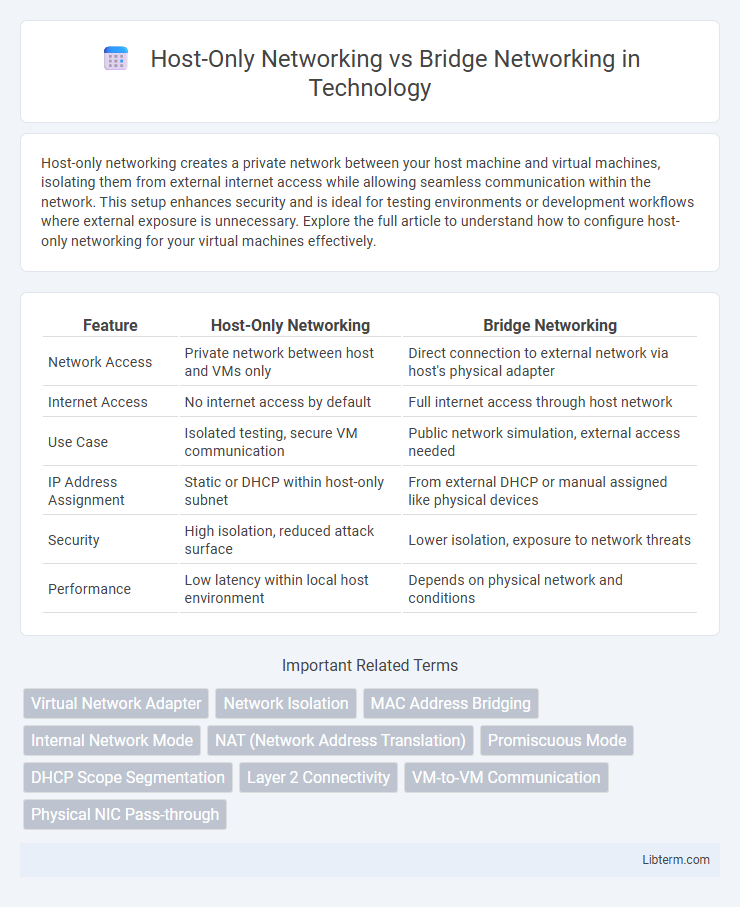Host-only networking creates a private network between your host machine and virtual machines, isolating them from external internet access while allowing seamless communication within the network. This setup enhances security and is ideal for testing environments or development workflows where external exposure is unnecessary. Explore the full article to understand how to configure host-only networking for your virtual machines effectively.
Table of Comparison
| Feature | Host-Only Networking | Bridge Networking |
|---|---|---|
| Network Access | Private network between host and VMs only | Direct connection to external network via host's physical adapter |
| Internet Access | No internet access by default | Full internet access through host network |
| Use Case | Isolated testing, secure VM communication | Public network simulation, external access needed |
| IP Address Assignment | Static or DHCP within host-only subnet | From external DHCP or manual assigned like physical devices |
| Security | High isolation, reduced attack surface | Lower isolation, exposure to network threats |
| Performance | Low latency within local host environment | Depends on physical network and conditions |
Introduction to Virtual Networking
Host-only networking creates a private network between the host machine and virtual machines, enabling isolated communication without external network access. Bridge networking connects virtual machines directly to the physical network, allowing them to obtain IP addresses from the local DHCP server and communicate like standalone devices. Virtual networking configurations impact security, resource access, and network performance in virtualization environments.
What is Host-Only Networking?
Host-Only Networking creates a private network between the host machine and virtual machines, isolating the VMs from external networks while enabling communication with the host. It is ideal for testing, development, and scenarios requiring secure, controlled environments without internet access. This type of networking enhances security by preventing external exposure and provides a stable, private connection for managing and troubleshooting VMs.
What is Bridge Networking?
Bridge networking connects a virtual machine (VM) directly to the physical network through the host's network adapter, allowing the VM to obtain its own IP address and appear as a separate device on the network. This setup enables seamless communication between the VM, other physical machines, and devices on the same local network or LAN. Bridge networking is ideal for scenarios requiring VMs to function as independent network nodes, supporting services like DHCP, file sharing, or web hosting.
Key Differences Between Host-Only and Bridge Networking
Host-only networking enables virtual machines to communicate exclusively with the host and other VMs on the same host, offering a secure, isolated environment without external network access. Bridge networking connects virtual machines directly to the physical network using the host's network adapter, allowing VMs to obtain IP addresses from the external DHCP server and communicate with other devices on the network. The key differences lie in host-only networking's network isolation and lack of internet access versus bridge networking's full integration into the physical LAN, enabling external connectivity and broader communication.
Use Cases for Host-Only Networking
Host-only networking is ideal for isolated virtual machine environments where direct internet access is unnecessary, such as testing software or development within a secure network. It enables communication between the host system and VMs without exposing them to external networks, enhancing security and control. This setup is preferred for scenarios requiring private networks, like running internal servers or sandboxed applications.
Use Cases for Bridge Networking
Bridge networking is ideal for scenarios where virtual machines require direct access to the physical network, such as running network services or hosting servers that need to be reachable by other devices on the same LAN. It enables virtual machines to appear as independent devices with their own IP addresses, facilitating seamless communication with external networks and other physical hosts. Common use cases include development environments needing real-world network conditions, web hosting, and testing network configurations in a production-like setup.
Security Implications: Host-Only vs Bridge Networking
Host-only networking restricts virtual machine (VM) communication to the host and other VMs on the same host-only network, minimizing exposure to external threats and enhancing security by isolating VMs from external networks. Bridge networking connects VMs directly to the physical network, allowing them to obtain IP addresses from the external network and exposing them to potential attacks such as unauthorized access, network sniffing, or malware propagation. Host-only networking provides a more secure environment for testing and development by limiting network traffic, while bridge networking offers greater flexibility at the cost of increased security risks.
Performance Considerations
Host-only networking provides isolated network access between the host and virtual machines, resulting in low latency and high throughput for local communication but no external network access. Bridge networking connects virtual machines directly to the physical network, enabling full network access with potential performance variability depending on the host's network congestion and hardware capabilities. For applications requiring minimal network delay and secure, isolated environments, host-only networking offers superior performance, while bridge networking supports broader connectivity at the cost of potential network overhead.
Choosing the Right Networking Mode
Host-Only Networking creates a private network between the host and virtual machines, ideal for isolated testing environments without internet access. Bridge Networking connects virtual machines directly to the physical network, allowing them to obtain IP addresses from the DHCP server and enabling full network communication like physical devices. Choose Host-Only Networking for secure, isolated development and Bridge Networking when virtual machines require internet access and seamless integration within the local network.
Conclusion and Best Practices
Host-only networking ensures isolated communication between the host and its virtual machines, making it ideal for testing and development environments without external network exposure. Bridge networking connects virtual machines directly to the physical network, providing seamless integration and allowing VMs to obtain IP addresses from the DHCP server, which suits production and multi-device setups. Best practices recommend using host-only networking for secure, local VM interactions and bridge networking when VMs require access to external network resources or must operate on the same subnet as physical devices.
Host-Only Networking Infographic

 libterm.com
libterm.com